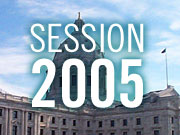January 27, 2005
 |
| Kindergarten student Sloane Rose Taylor works hard on a drawing. (MPR Photo/Tim Pugmire) |
Savage, Minn. — Kindergarten at Hidden Valley Elementary School in Savage goes well beyond singing and playing. These students are also learning to read and write -- tasks typically tackled in later grades. Teacher Katy Holden has her all-day class working on a book project. They're drawing pictures and cutting out shapes from colored paper.
This is the third year of all-day kindergarten at Hidden Valley. About three-fourths of the children are enrolled in the fee-based program. The rest are in traditional half-day classes, at no direct cost to their families. Katy Holden says the extra instruction time makes a big difference.
"It's a gift, because honestly, having them all day just lets me know my students better," Holden said. "I had taught first grade, and my love is literature, music and teaching reading. So, this just gave me exactly what I wanted to do with 5-year-olds."
Last year, Holden and her school were part of an experiment. The Burnsville-Eagan-Savage School District spent $500,000 on a pilot project that put every kindergarten student in a full-day program. There was no half-day option. There was also no fee charged. Superintendent Ben Kanninen says the switch made sense.
"We were absolutely confident that every student would benefit from this program," Kanninen said. "We knew that students with readiness deficiencies would benefit more. And we wanted to make it a universally available program, so as not to discriminate against those who might want such a program for their children but not be able to afford it."
The district's predictions proved accurate. The initial findings from a study of the program showed students who tested low at the start of kindergarten were able to catch up by the end of the school year. Kyla Wahlstrom of the University of Minnesota's Center for Applied Research and Educational Improvement says achievement gaps among racial groups also closed by the spring.
"The learning curve for all students really is remarkable in kindergarten," Wahlstrom said. "But I think that extra half of a day really shoved those lower performing, lower skill-based students up into the 100 percent range."
Budget pressures forced the district to retreat on its experiment after just one year. Last fall, families could again choose between all-day and half-day kindergarten. Nearly 70 percent picked the all-day option. The fee is based on family income, and ranges from $50 up to $175 a month.
Sherri Weber says she chose all-day kindergarten to help her daughter Brianna catch up to other children her age before first grade. Weber says Brianna is developmentally delayed, but has shown a lot of progress this year.
"I just know that she's learning faster than she would with half days," Weber said. "She's getting twice as much knowledge this way."
Many parents say their children were eager for a full day of learning. But others worry the academic expectations for children are coming too hard and too soon.
Clare Anderson is a Burnsville parent who opposes the push toward all-day kindergarten. She agrees some at-risk children might benefit from the extra classroom time. But Anderson says six hours away from home is inappropriate for the majority of 5-year-olds.
"We're just pushing, pushing, pushing pushing," Anderson said. "And I think these kids need to be kids. They need to be home. They don't need to be reading when they're 5."
Similar concerns among state lawmakers could quell support for an all-day kindergarten bill. So could the cost. Legislative leaders estimate the annual price tag at $140 million dollars. Nationwide, only seven states currently fund all-day kindergarten.







